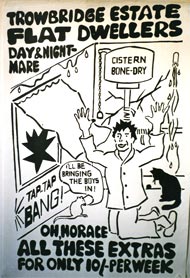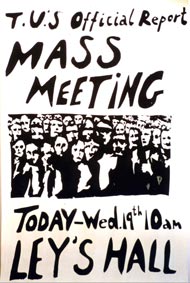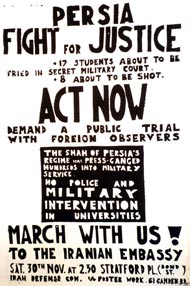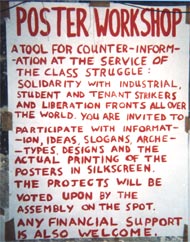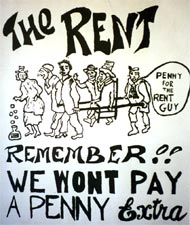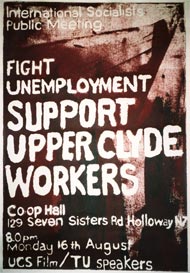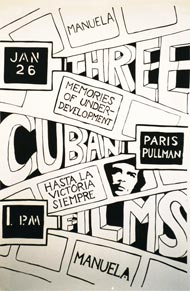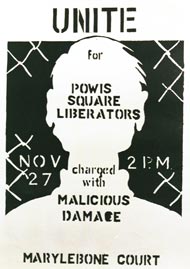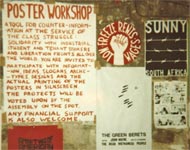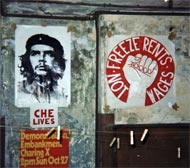
|
BIRTH OF THE POSTER WORKSHOPEarly in ‘68, after leaving Bath Academy of Art, Sam Lord built a screen printing vacuum table in the kitchen of a flat he shared at 51 Moorhouse Rd, Notting Hill Gate, London. A number of posters were printed there, some with the assistance of Peter Dukes, a law graduate, and Dick Pountain. Sam had met Peter at a meeting of the AgitProp Information Service, held at John Hoyland’s house in Tufnell Park. Later, in June, they met Jean Loup Msika, a French Tunisian who had been expelled from France because of his involvement with the Atelier Populaire and the May events in Paris. (He was allowed to return the following year as a result of a campaign supported by Jean Paul Sartre and Simone de Beauvoir). Peter then found new premises at 61 Camden Road, a dingy basement beneath the Marylena Hairdressing Salon. The printing table and equipment were moved there. Jean Loup donated some posters from the Atelier Populaire which were flyposted in the stairwell to provide inspiration and encouragement. Buoyed up by a great deal of political enthusiasm, the Poster Workshop was able to flourish almost immediately as a vibrant source of radical political posters in London and beyond. Its fame spread mainly by word of mouth. All kinds of people came there when they needed posters. GLC (Greater London Council) tenants’ associations, protesting against steep rent rises; striking workers at the Dagenham Ford plant; Anti-Apartheid groups; Civil Rights, freedom and liberation movements from all over the world; anti Vietnam War groups; Black Power movements; California Farm Workers Union; the GLC fire brigade; CND (the Campaign for Nuclear Disarmament); International Socialists (now Socialist Worker); Young Communists; radical film and theatre companies; Situationists, King Mob, and many different student organisations. POSTER WORKSHOP AND ITS CORE GROUPSam, Peter and Jean Loup were soon joined by others. Jo Robinson had been working as a scenic designer for the Unity Theatre in Mornington Crescent, Camden. This was where she met Ian Purdie, from whom she learned about the Poster Workshop. Ian also told a number of other people about the workshop, some of whom became members of the core group. Frederick Egbert Scrivener, (Scriv for short), was one, and another was Sarah Wilson. Jo and Sarah, like Sam, had been to art school. Sarah had recently returned from stays in Algeria, Paris, in 1967 & 1968, and then Cuba. Peter dealt with the landlord and finances, drove around London picking up ink and paper, and generally kept the place functioning, as well as working on the printing. No one received any payment for working at the Poster Workshop. Most participants were part time, often with a paid job, (cleaning, teaching, working in bars). Scriv was a pensioner and would stay there all day. Others who contributed were Billy Old, Detta Kelly and Martin Atwood, who had also graduated from Bristol art school. There were several other committed regulars, such as Alison Waghorn, and Harry Beck. Harry worked in a dry cleaning shop opposite. He became intrigued by the sight of streams of people and posters emerging from the dingy basement, came to investigate and joined us. Two other regulars were Bernard, (whose surname we somehow never knew) and Valerie Kemp,( a friend of Sarah’s from Art school days) There were many others who joined in at various times. Everybody mucked in and took part in the printing, passing the posters along as they were printed, and hanging them up with pegs on the ‘washing lines’. COST EFFECTIVEPosters were printed by silkscreen, using very simple rudimentary techniques. Printing presses at that time were expensive to buy, it was very costly to have posters made and to be at all cost-effective thousands of one image needed to be printed. Silkscreen methods meant people could have just 50 or 100 posters if that was all they required. However, most of the time we made runs of 200 or more. FINANCING THE WORKSHOPThere was no fixed charge for posters. The idea was that groups paid what they felt they could afford towards the cost. Our funds were boosted by benefit shows given by - in particular - CAST theatre group, and Agitprop Street Players, (soon to be renamed Red Ladder Theatre), of whom Peter was a member, and by donations. One of our number used a small income they had to pay the rent every week. In practice, the voluntary payment system meant that some groups, (such as council tenants or factory workers, for example), paid scrupulously if not over generously, whereas some of the less well organised (e.g students associations) were more variable in their contributions. We were also given some paper and ink, and huge quantities of unwanted posters - we printed on the reverse side. ORGANISATION OF THE WORKSHOPThe majority of the posters were made at the request of specific groups and, with a few exceptions, they were not our own slogans. Decisions on posters were usually made by whoever was around at the time. From time to time there were bigger meetings, but much that happened was on an ad hoc basis. Some people were involved in certain campaigns more than others. Scriv, who was a born and bred East London council tenant himself, dreamed up almost all of the GLC rent strike designs. He was to be found with a fag permanently hanging out of his mouth, often standing ankle deep in discarded inflammable rags. Many people smoked. Conditions in the basement were altogether pretty dire. Most of the solvents and cleaning products gave off toxic fumes, as well as being combustible. The basement had two small rooms, and a tiny space at the bottom of the stairs with notice board etc. Most work went on in one room - designing, discussing, printing. The other room had lines on which the posters were hung up to dry - later, drying racks were made. There was a large opening in the wall in that room, where there had once been a window, but it was now open to the weather. There was no heating and there were times in winter when we just had to pile on more jumpers as we hung out posters on lines bedecked with icicles. But in summer it could be suffocatingly hot, though Scriv being a true Cockney invariably wore a waistcoat, tie, and hat. ‘RAPID RESPONSE UNIT’We could if necessary respond very rapidly to a request for posters. The most extreme case was probably for a strike at Fords, Dagenham. The vote to strike was taken at a meeting at 10 p.m., and the shop stewards rang through to the landline of the local pub, where we were waiting for their call. (No mobile telephones in those days). They needed posters to put out around the factory in time for the 6 a.m. morning shift. We worked through the night designing, printing, and finally drying the posters with a hairdryer, before driving out to Dagenham before dawn, in time to hand them over to the shop stewards . TRAVELLING WORKSHOPSSince silk screen printing does not involve a press or expensive equipment we could also create workshops in other places at very short notice when asked, and if desired teach the people there how to make their own posters. The first workshop to travel was set up in the refectory of the LSE, (London School of Economics), by Sam Lord and Pete Binns, soon to be joined by Peter Dukes, Jo and Sarah. The LSE had been occupied by the students prior to the massive October 27 anti Vietnam war demonstration. The atmosphere was vibrant and dynamic. The workshop there made some memorable posters and placards for the demonstration, as well as responding to a debate in the House of Commons, with ‘We are all Foreign Scum’, and ‘Guy Fawkes The only man to enter Parliament with honourable intentions’.. In the snowy February of 1969 Peter, Sam and Jo went up to Essex University. The intention was to teach the more militant students how to screen print. In the north of Ireland, in August 1969, we set up workshops in the heart of Free Belfast and Free Derry at the request of People's Democracy,. These areas had been barricaded by Republicans and citizen’s groups, following attacks on Catholics by Loyalists and B-Special forces, as a result of which British troops were brought onto the streets . The demand for posters was enormous.There was an urgency and energy. Requests for new posters came in continuously, with queues waiting for fresh batches. Everything produced was immediately posted up. Also in Ireland, the Land League in Galway wanted posters for a campaign against the sale of good farming land for the creation of golf courses. We made these on an island on Lough Corrib, where playwrights John Arden and Margaretta D’Arcy lived with their four boys. The posters were printed on a table in the open air and hung up to dry on lines strung between the trees. The Land League were very secretive about their identity. When the posters were ready two men came out to the island in a boat, took them and all trace of them, and rowed away into the night. However, more than 90% of the posters were designed and printed in the Camden Town basement workshop. About 210 different posters were made altogether, making an overall total of more than 50,000. The workshop continued into 1971. By this time small, relatively inexpensive, offset Litho printing presses had become available, and a number of organisations such as Black Dwarf, and International Socialists, had bought one and were able to make posters for more accessible commercial rates - though nothing could compare with the low to zero rates of Poster Workshop. The Poster Workshop existed at an exceptional time. It thrived on the energy generated by the belief that huge changes were possible - indeed were already taking place around the world, through growing movements for equality, civil rights, justice, freedom, democracy and revolution. The posters made there show the extraordinary diversity of those who came to the workshop. It was a microcosm of much that was happening nationally and internationally. It was an expression of that time - of excitement, change, and hope. This is now reflected and connected by the sudden rise of recent outpourings of hand-made posters being shared on the internet , social media and on demonstrations protesting against today’s wars and injustices. La Lutte Continue, February 2018 HISTORY OF THE WEBSITEAfter the closure of the workshop in 1971 people gradually lost touch with each other. However, Sam Lord and Peter Dukes remained friends, as did Jo Robinson and Sarah Wilson. In 1995 Sarah managed to track down Peter and photographed his entire collection of over 200 posters. (Later losing touch again when Peter moved house). In 2008 Jo and Sarah went to a couple of exhibitions of radical posters commemorating the 40th anniversary of 1968. They were shocked to discover that there was no mention of Poster Workshop. It seemed to have been forgotten. To remedy this they set up this website, made in 2009 by Pennine Pens, Hebden Bridge. This has firmly re-established Poster Workshop’s rightful place in history. Many things have resulted from this. There have been requests to include PW posters in a number of shows and exhibitions in 2018, marking the 50th anniversary of 1968. These are Tate Britain ; the Museum of Street Art in Brussels; the Polin Museum in Warsaw; and possibly the Arts Festival in Cortona in Italy. An excellent article by Steve Rose was published in the Guardian newspaper in March 2011, which drew attention to Poster Workshop and our website; as a result of this there was an online article in Spain's El Pais; and we were included in a catalogue of an exhibition in Ballarat, Australia. There have been interviews for a number of PhD theses, including by Catherine Flood, Curator of Prints at the V&A, and Jess Baines, Senior Lecturer at the London College of Communications. Peter and Sam later met up with Jo and Sarah again, so there is now a surviving core group of four, preparing for the 50th anniversary of 2018. Peter has miraculously maintained the only remaining set of original posters, about 200 or more, without which none of these things could have happened and Poster Workshop would probably have lapsed into obscurity. Sam Lord has produced a splendid book of all Poster Workshop’s posters, helped by Jo Robinson, Sarah Wilson and Peter Dukes. This is now being published by Four Corners publishers. Recently all four spent three days in London being interviewed and filmed by Michael Lellouche, a French filmmaker who is the curator of the Brussels museum exhibition. Michael has been collecting radical posters for 25 years. He has an extensive knowledge of the scene and possesses about 1500 radical posters from around the world. He has observed that we were one of the most important, prolific, and long-running workshops of that time; Atelier Populaire in Paris continued for 50 days, and Berkeley for 30 days. Poster Workshop lasted for 3 years. January 2018 Website: Chris Ratcliffe of Pennine Pens, Hebden Bridge . |
|


